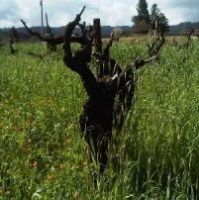Our unique Old Vines Register

10 February 2021 If you're looking for the latest information on our Old Vine Register, please see Our Old Vines Register updated.
28 November 2019 On this Thanksgiving Day we give thanks for all the ancient vines that have somehow escaped being pulled out in favour of younger, more productive vines by republishing this list of particularly ancient plantings. Many of them are capable of producing hugely distinctive wines, and of course can provide genetic material that is likely to be increasingly useful in the future, as Dr José Vouillamoz argues in Climate change discussed in Montreal.
Since we last published our register, the Old Vine Project has been launched in South Africa; a list of all plantings of vines over 35 years old can be found here. And there has also been much more work on preserving the old-vine heritage of the Barossa Valley in South Australia. See the Barossa Old Vine Charter for more details.
Please fee free to feed in information about particularly ancient vines via the Contact link at the bottom of this page.
22 August 2013 – Yesterday's article on Gypsy Canyon's Central Coast Angelica referred to our unique register of the world's oldest vines, originally and painstakingly assembled by Tamlyn Currin in 2010 but updated occasionally since. We anticipate more input on South Africa's old vines but would always welcome more input. Please note!
But there is already a wealth of information in this attempt to provide a focal point for a register of the world's stocks of older vines, a precious global resource, as highlighted in World heritage in the vineyard.
So far we have relied on a variety of very different sources, including the much-appreciated input of many Purple Pagers in this Really old vines? thread on the forum.
The most admirably thorough set of information comes, appropriately enough, from one of the world's great sources of ancient vines, California. One of the few benign effects of Prohibition was to preserve many ancient vineyards because it was simply not worth the cost of replacing the vines. The Historic Vineyard Society is an admirable organisation designed to preserve the state's stocks of ancient vines.
Our register also includes a set of data, very differently presented, on the vines planted in another rich resource of ancient vines in South Australia's Barossa Valley. I asked Peter Gago of Penfolds, who is very familiar with Barossa, exactly why it was that there were so many very old vines there and this is his reply:
'Back in the early to mid 1800s, winemaking over here in the distant colony of South Australia (Adelaide founded in 1836, Penfolds in 1844), was predominantly fortified. Portuguese varieties were not used, rather Shiraz, Grenache and Mourvèdre. Many of these original vines remain ...
'Most importantly, South Australia didn't have to deal with phylloxera. Our forebears were also a touch conservative – didn't respond to dictates of (viticultural) fashion ... replanting new varieties, etc.
'South Australia is deemed to be the driest state, in the world's driest continent. We have a winter-dominant rainfall. Dry conditions minimise the susceptibility to disease, nurturing naturally healthy vines.'
It was Sam Holmes of Barossa.com and his tasting of particularly old-vine Barossa wines last January [2010] who inspired me to pursue this whole topic. When we showed him the format of the Historic Vineyard Society in California, his reaction was 'I love the California register and we will be totally plagiarising their work', which is excellent news for us all.
Meanwhile, do please keep information on older vines around the world flowing in.
Become a member to view this article and thousands more!
- 15,434 featured articles
- 274,222 wine reviews
- Maps from The World Atlas of Wine, 8th edition (RRP £50)
- The Oxford Companion to Wine, 5th edition (RRP £50)
- Members’ forum
- 15,434 featured articles
- 274,222 wine reviews
- Maps from The World Atlas of Wine, 8th edition (RRP £50)
- The Oxford Companion to Wine, 5th edition (RRP £50)
- Members’ forum
- Commercial use of our Tasting Notes
